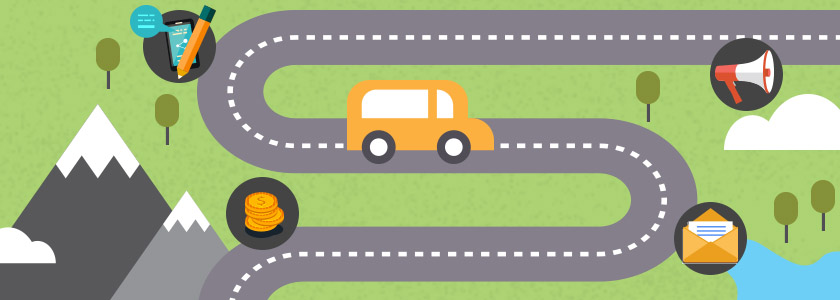
The Customer Value Journey is an eight-stage process, coined by
DigitalMarketer, that every new prospect goes through in order to become a
customer, and eventually, a raving fan. This process is the foundation of successful marketing, creating a
roadmap that moves prospects predictably from stranger to customer and beyond.
In this article, we’ll touch on the first four stages in the
Customer Value Journey:
- Aware Stage
- Engage Stage
- Subscribe Stage
- Convert Stage
1. Aware Stage
The first stage in the Customer Value Journey is to make
people aware you exist. No one can buy from you if they’ve never heard of you. At
some point, your potential customers have to learn who you are and what you
offer.
Here are some examples of digital marketing activities that boost brand awareness:
- A mother sees a Facebook ad for a new children’s diaper
brand on Facebook
- An accountant searches Google to find a new payroll
system
- A college student watches an influencer's sponsored video about a new skincare brand
2. Engage Stage
Now that your prospect is aware of you, it’s time to start
developing your relationship with them. The way you do this is by engaging them through relevant content that's educational, informative, or entertaining.
Engagement is something that continues throughout the Customer Value Journey,
but it's especially important when introducing your business and building trust.
Here are some examples of marketing tactics that generate engagement:
- A newly engaged woman takes a quiz from a wedding planner to identify her wedding
style
- A 60-year-old man receives an e-newsletter with retirement tips from his financial
advisor
- A seller of custom car parts becomes active in a car enthusiasts Facebook group
3. Subscribe Stage
By this stage, your prospect knows who you are and has
engaged with you in some way. However, if you don’t collect their contact
information, odds are that you might not ever hear from them again. Why?
People today are inundated with marketing messages from
many different companies. Just because they read one blog post from you doesn’t mean
they’re hooked. That’s why stage three in this process is to get them to
subscribe to you.
Often, in order to get them to subscribe (or give you their
information), you offer a 'lead magnet' such as free content, products, or
services in return.
Here are some
examples of ways to build your email list with lead magnets:
- A first-time homebuyer downloads a free guide from a local realtor
- A business owner registers for a webinar from a marketing agency
- An HR manager fills out a form for a free trial of a
new HR software
4. Convert Stage
As you gain more subscribers and are continuing to engage
them, chances are that some will be ready to take the next step with you. The key to this stage is offering what is known as 'entry-point' offers. These are designed to give the new prospect incredible
value without pushing them to put too much "skin in the game."
During this stage, try not to overly concern yourself
with profitability. The truth is that during this stage, you might
even lose money on prospects that you acquire as buyers. The Convert stage is about just that, ramping up the commitment and
converting them from prospect to customer.
Here are some
examples that real businesses use as entry-points:
- Sprint offers to buy out your Verizon contract
- VistaPrint sells 500 business cards from $9.99
- GoDaddy offers domain names from $0.99
None of these upfront offers make much money, if any, for
the companies, but it’s a chance to further the relationship and
move the customer further along the Customer Value Journey.
Halfway There...
Understanding these stages is essential for building a fine-tuned marketing system that generates leads and retains customers. There are still four more stages to go to layout the foundation for your marketing. Check out Part 2 where we discuss how to turn these low-dollar
offers into true revenue-generating customers, and eventually raving fans.
Schedule a free, no-obligation meeting with Sales & Marketing Technologies now to see how sales-driven marketing maximizes results!
Editor's Note: This post was originally published in January 2018 and has been updated for accuracy and comprehensiveness.